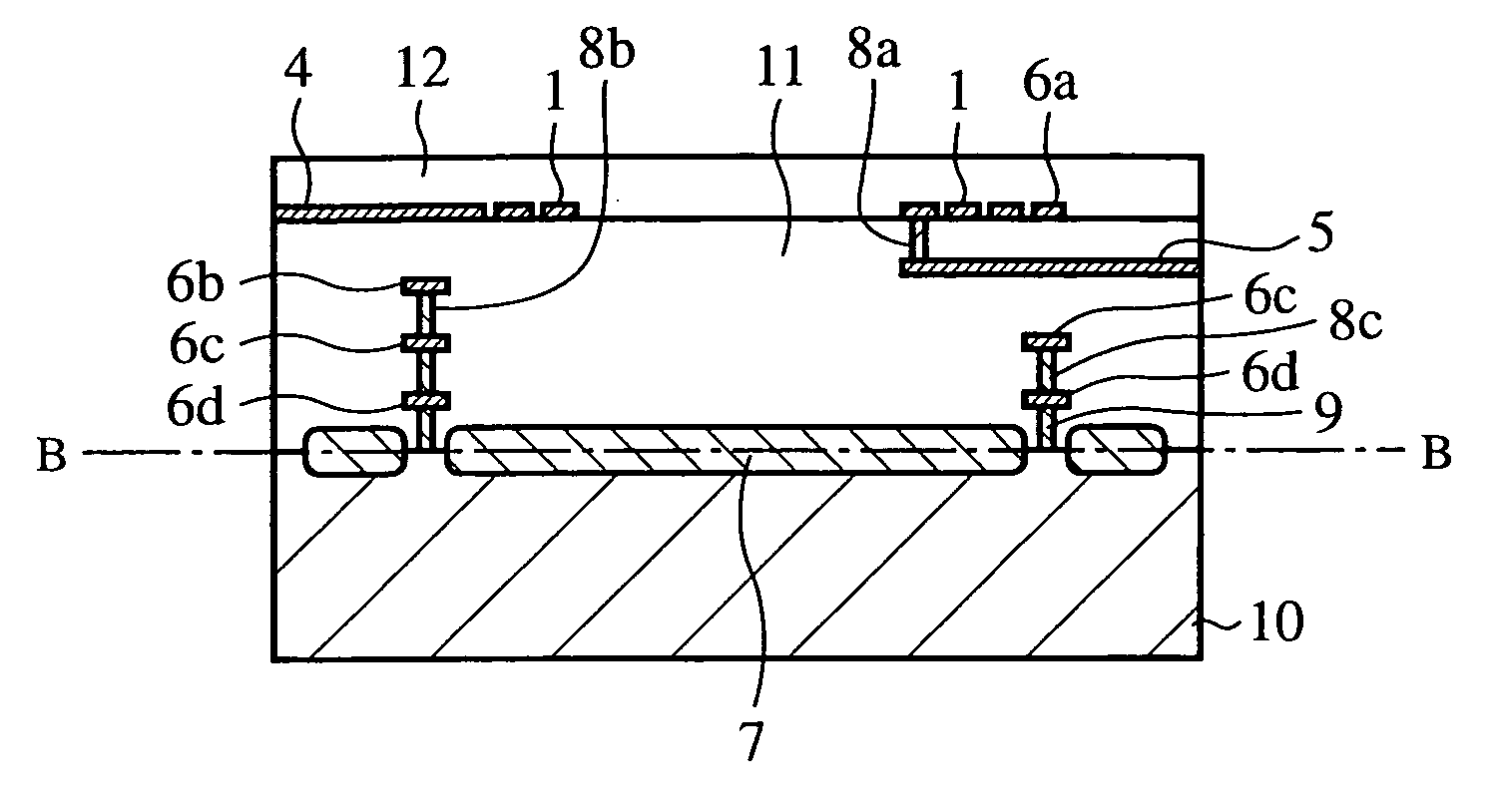Semiconductor device
a technology of semiconductors and devices, applied in semiconductor devices, semiconductor/solid-state device details, inductances, etc., can solve the problems of only reducing electromagnetic interference, the length of the line connecting the elements becomes long, and the inductor cannot offer its intrinsic performance, so as to reduce the capacitance between the terminals of the inductor, reduce the electromagnetic interference between the inductor and other elements disposed therearound, and reduce the electromagnetic interference
- Summary
- Abstract
- Description
- Claims
- Application Information
AI Technical Summary
Benefits of technology
Problems solved by technology
Method used
Image
Examples
embodiment 1
[0038]FIG. 1 is a perspective plan view of a semiconductor device in accordance with Embodiment 1 of the present invention, as seen through a passivation film and an interlayer film from above, and FIG. 2 is a top view showing the pattern of the inductor of the semiconductor device. In the semiconductor device in accordance with this embodiment, as shown in FIG. 1, a shield 6a is provided such that the shield encloses an inductor 1 formed by laying out a interconnection in a spiral form. The dimensions of the inductor 1 are, as shown in FIG. 2, such that, for example, the interconnection width Wi is 10 μm, the interconnection spacing A of the spiral pattern is 2 μm, and the number of interconnection turns of the inductor is 2.5. The high frequency signal input from an input terminal 2 is output from an output terminal 3 through a lead wire 4, the inductor 1, and a lead-out wire 5. Moreover, a trench isolation part 7 is composed of silicon oxide and so on, and electrically separates ...
embodiment 2
[0097]FIG. 14 is a perspective plan view of a semiconductor device in accordance with Embodiment 2 of the present invention, as seen through a passivation film and an interlayer film from above. FIG. 15 is a sectional view of the semiconductor device shown in FIG. 14, taken along the line D-D. As shown in FIG. 14, in the semiconductor device in accordance with this embodiment, a shield 6e is provided such that the shield encloses an inductor 1 formed by laying out a interconnection in spiral form. Herein, the dimensions of the inductor 1 are such that the interconnection width Wi thereof is 10 μm, the spacing A in the spiral pattern is 2 μm, and the number of turns therein is 2.5.
[0098] Further, as shown in FIG. 15, the semiconductor device in accordance with this embodiment has four-level aluminum interconnection layers layered on a silicon substrate 10 through insulating layers by means of a CMOS process. The inductor 1 is formed in each of the fourth aluminum interconnection lay...
embodiment 3
[0114]FIG. 17 is a perspective plan view of a semiconductor device in accordance with Embodiment 3 of the present invention, as seen through a passivation film and an interlayer film from above. The semiconductor device in accordance with this embodiment has, similarly as in Embodiments 1 and 2, four-level aluminum interconnection layers layered on a silicon substrate 10 through insulating layers by means of a CMOS process. An inductor 1 is formed in the fourth aluminum interconnection layer, which is the top layer, coated with a passivation film 12. A lead wire 4 and the inductor 1 are both formed in the fourth aluminum interconnection layer. A lead-out wire 5 is formed in the third aluminum interconnection layer, and is electrically connected with the inductor 1 formed in the fourth aluminum interconnection layer through a via hole. The high frequency signal input from an input terminal 2a is output from an output terminal 3a through the lead wire 4, the inductor 1, and the lead-o...
PUM
 Login to View More
Login to View More Abstract
Description
Claims
Application Information
 Login to View More
Login to View More - R&D
- Intellectual Property
- Life Sciences
- Materials
- Tech Scout
- Unparalleled Data Quality
- Higher Quality Content
- 60% Fewer Hallucinations
Browse by: Latest US Patents, China's latest patents, Technical Efficacy Thesaurus, Application Domain, Technology Topic, Popular Technical Reports.
© 2025 PatSnap. All rights reserved.Legal|Privacy policy|Modern Slavery Act Transparency Statement|Sitemap|About US| Contact US: help@patsnap.com



